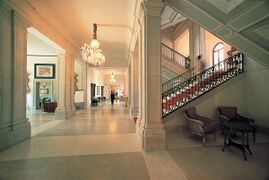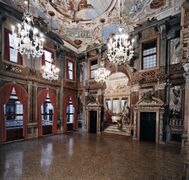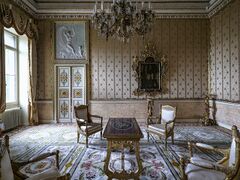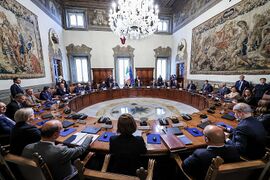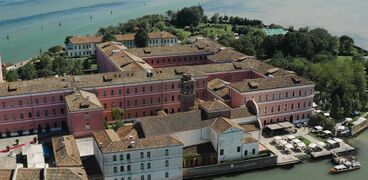Isola di San Pietro: Difference between revisions
| Line 89: | Line 89: | ||
File:BarbarigoTeaRoom.jpg|<center>The Barbarigo Tearoom is often used for private meetings</center> | File:BarbarigoTeaRoom.jpg|<center>The Barbarigo Tearoom is often used for private meetings</center> | ||
File:Libreria Pisani Correr.jpg|<center>The San Pietro State Library</center> | File:Libreria Pisani Correr.jpg|<center>The San Pietro State Library</center> | ||
File:ChurchandMonestarySanPietro.jpg|< | File:FederalCouncilofMinistersRoom.jpg|<center>The [[Federal Cabinet of Etruria|Federal Council of Ministers]] is hosted in the Monastic Complex | ||
File:ChurchandMonestarySanPietro.jpg|<center>The Monastic Compelx is the large building with the pink facade</center> | |||
</gallery> | </gallery> | ||
Latest revision as of 13:50, 10 June 2023
| Isola di San Pietro Ixoła de Santo Piero | |
|---|---|
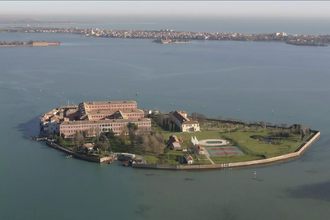 | |
| General information | |
| Architectural style | Solarianesque, Baroque |
| Town or city | Povelia |
| Country | Etruria |
| Current tenants | Francesco Carcaterra (President of Etruria) |
| Construction started | 1508 |
| Completed | 1512 |
| Design and construction | |
| Architect | Unknown |
Isola di San Pietro (Povelian: Ixoła de Santo Piero; Island of Saint Peter) is a small island in the Povelian lagoon and the official residence and office of the President of Etruria.
Colloquially known as San Pietro, the island is located 1.25km south across the Lagoon from the Spinalunga island of Povelia. Originally established as a monestary by the Augustine canons and later developed into a hospital with the support of the resident priests and wealthy Povelian families, it was donated to the Etrurian Second Republic by the Augustine canons, for personal use by Chief of State, Cardinal Romolo Alessandri, the-then head of state. It was officially adopted as the residence of the President of Etruria by order of Alessandri upon his death in 1899. Renovation work took place under Alessandri's tenancy and would continue for several years under successive presidents, though the original church dedicated to Saint Peter would remain untouched and in active use.
The island consists of several buildings, including the original church and monestary, both of which dating back to the early 16th century. The monestary building itself was renovated to provide offices, conference, reception, sitting and dining rooms where the president works, and where government ministers, foreign leaders and dignitaries are met and hosted. A second large building south of the monestary complex hosts the private residence of the president and their family. It contains approximately 40 rooms, including a gymnasium, sauna, cinema and library. The island also hosts a swimming pool and a tennis court and a large outside open dining area, as well as 15 acres of gardens. Smaller buildings on the island contain spaces and offices for the State Protection Service and other infrastructure. The island is accesiable by boat and helicopter, which is accessible via the garden.
The island as the official residence of the President has been a source of controversy throughout its use, with many describing Saint Peter's as "opulent" and "gratuitously lavish." However, numerous foreign dignitaries as well as Etrurian presidents have remarked on its privacy, the luxury and the resplendent views of Povelia.
History
According to historical city records, the island was first settled in 1109, when a church was built using funds donated by local merchant Alessandro Galatan. He not only funded the construction of the church, but also buildings to house a hospice for pilgrims travelling through Povelia to the Holy Land accross the Solarian Sea. The church was dedicated to Saint Peter, owing to Galatan's birthday being the saint's feast day according to the Church's records. The church and island was run by Augustine monks, at the personal request of Doge Michele Ànxelo Collegario, with the island falling under the jurisdiction of the Archdiocese of Povelia. From 1289 to 1293, the island and its church was used as a waystation, temporarily holding relics pursued by Povelian merchants in Tsabara for collection within Povelia. A popular myth includes the island once housing the Spear of Longinus and a fragment of the True Cross, however, no official documents confirm this.
In 1346, the island received a significant boost when Pope Clement XII authorised the movement of the Canons Regular of Saint Augustine to the island. With significant donations provided by Povelian merchant families and Doge Giovan Aurelio dalla Stava, the existing monestary was significantly expanded. Numerous frescoes and sculptures were provided free-of-charge by Povelian artists, including Tiziano della Vadera as an apprentice in 1472.
Between 1369 and 1371, the island's resident monks established a hospice on the southern side of the island to provide care for plague victims. It is understood that the island provided this service owing to the use of neighbouring Isola di Santa Cecilia as a quarantine site for merchant vessels entering the lagoon. Though records of this particular outbreak in Povelia's history have been lost, it was confirmed with the discovery of 80 skeletal remains within the island's gardens during the construction of the swimming pool.
In 1647, to honour the work of the resident Augustine order during a previous plague epidemic, the city's wealthy merchant families once again funded the building of a new chapel, however, this new chapel would be constructed inside the existing San Pietro Church, with the "church in a church" construction remaining a prominent feature to this day.
In 1689, the Benedictine Camaldolese Order purchased the island off the Augustine Order and assumed ownership of the islands. The arrival of the Benedictine Camaldolese was followed by further donations by merchant families, who funded the restoration of the San Pietro Church's facade, expansion of the monestary and improvements to the island's well. However, the Augustine canons would return the island in 1701, by order of Povelian Pope Benedict IV, the Augustine monks would retain ownership over the island until its donation to the Second Republic in 1889.
The fall of the Povelian Republic in 1787 would herald a significant change to life on the island. The Augustine Canons were notably supportive of the Etrurian First Republic and acquiesced to the construction of small prison on the island, where suspected enemies of the revolution were detained. There exist conflicting reports as to whether San Pietro was used for Lagoon Burials, a form of execution in which individuals are bound together and chained to rocks, before being thrown into the Povelian Lagoon. However, records do exist that reveal between 20 and 50 individuals were killed by hanging on the island between 1790 and 1792. Between 1793 and 1810, the island housed a hospital for wounded soldiers returning from the Liberation Crusades.
Following the Caltrini Restoration and establishment of the United Kingdom of Etruria, the island resumed its historic role as an isolated monestary for the Augustine order.
Donation to the Republic
In the late 19th century, the Etrurian monarchy was facing growing fury and public resentment. The shock defeat in the Etrurian-Shangean War culminated these tensions into the San Sepulchro Revolution in 1888, resulting the establishment of the Etrurian Second Republic under Chief of State Cardinal Romolo Alessandri. Prior to assuming this political office, Alessandri had served as the Archbishop of Povelia and had enjoyed a long and warm relationship with the Augustine monks of San Pietro. One of Alessandri's first efforts was to establish a new federal capital for Etruria, out of the desire to dampen tensions rising between the Vespasian states and the western states of Carinthia and Novalia; but also out of his respect for the Solarian Catholic Church, who long opposed Solaria serving as Etruria's capital. The decision was made in late 1888 to move the capital to Povelia, while Alessandri's resignation as Povelia's Archbishop to enable his continued role as Chief of State meant he required new lodgings and office. In December, the Augustine Canons on San Pietro invited Alessandri to reside there until a new office and residence was found, yet, by January, the Augustine order had officially donated the island to the Second Republic for official use by Alessandri and his office.

The Chief of State reportedly resisted this, citing the order's centuries long residence on the island, though this was settled by Pope Pius VIII intervention by authorising the move of the Augustine canons to Montetrinità in Palestrina. The island was officially inaugurated as the residence and office of the Chief of State in a lavish event on 13 February 1889. Alessandri would reside on the island exclusively until his death in 1899, when he officially bequethed it to the state in his last will and testament.
Official State Residence
Following the death of Alessandri, Alfredo di Rienzo, the first elected President of Etruria moved onto the island with his wife Sofia Maria and four children. His wife, a prominent socialite oversaw the renovations of the former Augustine apartments, converting them into a lavish private residence. She did so in cooperation with several Etrurian museums and galleries, who worked to establish the renaissance-era aesthetic of the private residence which remains in place today.
In 1902, Di Rienzo authorised the establishment of the Federal Office for the Presidential Estate, which would manage both San Pietro and various other amenities. The FOPE was officially mandated to establish relationships with galleries and museums for the display of artworks, antique furniture and other furnishings in both San Pietro and the Casa della Contemplazione, a large former monastic complex in rural Carvagna, which serves as the summer residence for the President and family.
In 1905, Giorgio Maria Schiavi was elected President, though as a senator for Povelia, had retained his private home in the old city itself, rarely making use of the private residence on San Pietro. Schiavi was also a noted disgruntled tenant of the island, describing it in a letter to his brother as a “lavish sore upon the republic, Presidents serve upon the confidence of the Senate, yet, I am expected to live as a Doge like it is the 15th century. I question this luxury’s value as denoting our nation as an elected monarchy.” Despite this opinion, Schiavi and his wife, Claudia, would regularly oversee and assist restorative efforts and even privately funded repairs to the island. By 1908, the Schiavis were regularly hosting dinners and balls on the island.
In 1910, the Schiavi family were replaced by Marco Antonio Loredan and his family. Loredan, a Veratian senator, became an “instant fan” of the island. President Loredan, purportedly boasting a family lineage dating back to the height of the Povelian Republic worked closely with the FOPE to further furnish the island with artefacts, furniture and light fittings of Povelian origin. Loredan would also oversee the electrification of the island between 1912 and 1913. Loredan’s wife, Serafina Louisa oversaw renovations to the private residence building, converting two sitting rooms into a large baroque-styled ballroom.
Alessandro Luzzani and his family moved to the island in 1916, though the Luzzanis would be one of the most prominent critics of the island, for its isolation, opulence and being accessible only by boat. President Alessandro Luzzani was well known publicly for being sea-sick each time he travelled from San Pietro to the Palazzo Orsini in Povelia for parliamentary business. By 1917 however, the Luzzanis had moved out of San Pietro into a private apartment in the Palazzo Madonna, a large villa on the Isola Constituzionale, the location of the Palazzo Orsini. They would not return throughout Luzzani’s tenure, leaving the island shuttered until 1921.
Discovery of plague pit
Features and buildings
The island of San Pietro is approximately 62,000m² (15.32 acres) in size, 230m (750 ft) at its widest point and 380m (1,250ft) at its longest. The island sits at an elevation of 4m (13ft) above sea level, though is lined with walls 3m tall, to protect it from the Lagoon's common tidal flooding. It is located 1.25km from Spinalunga, the southern most island of the historic island-city, and 4.2km south of the Isola Constituzionale, the location of the Senate of Etruria. Access to the island is provided by a marina and flattened grassy area for helicopters, an internal tunnel was added in 1952 to provide a second water-borne access point. This tunnel leads into a large holding area inside the former storehouse of the monestary.
The complex of buildings includes the historic San Pietro Church, the former Augustine monestary, its assortment of storehouses and guesthouses, the private residence and a small villa previously held by the canon-superior during the Augustine order's ownership of the island.
San Pietro Church
The Church of Saint Peter is the oldest building on the island and one of the oldest churches in Povelia to still be in use. It has undergone repeated renovations and repairs to maintain its original facade and interior throughout its thousand-year history. Though debate continues as to the location of the original chapel built in the 12th century, as doubts exists as to whether the current Church sits atop the foundations of the original. The Church and its internal chapel are both actively used by the Etrurian first family, administration and island staff.
The Church has seen use in weddings and baptisms alike, with the eldest daughter of President Gabriele Rumor being wedded there, the son of Fiorino Bianco, Vincenzo Biava's son was wedded at the church, while all four of his grandchildren were baptised at the Church. Since becoming president in 2016, Francesco Carcaterra has offered the Church for Representatives of his Tribune Movement. Up to 10 Tribune representatives have been wedded at the Church, while 26 children have been baptised. In 2017, President Carcaterra made mass attendance mandatory at Nativity, Easter and the feast days of Saint Augustine and Saint Peter, the former out of respect for the Augustine Canons and the latter for the Church's namesake.
In 2021, it was confirmed that several presidents relied upon the resident priest of the church as their confessor. However, it was also confirmed that president Carcaterra regularly invites Matteo Andrea Caravello, the Archbishop of Povelia to hear his confession, as Caravello has served as the unofficial Confessor to the Republic since 2017.
Monestary
The large monastic complex built beside the Saint Peter church constitutes the hub of activity on San Pietro, with its interior converted into office space for workers of the Etrurian executive. The large building contains over 500 rooms, a large ballroom and library. The eastern wing of the building contains single-use bedrooms for staff who are required to stay overnight due to work or emergencies, each bedroom has been renovated in a baroque style and numerous accounts from civil servants over the decades have each expressed great satisfaction out of staying there.
The northern wing of the Monestary contains larger and more luxurious apartments for visiting dignatries, including foreign leaders, representatives and domestic dignataries. Each of the fifteen apartments are modelled around each of the Etrurian states, and all have a northerly panoramic view over the Lagoon toward Povelia.
The most prominent feature of the monastic complex is the Hall of San Vittore, located in the southern wing, this vast room two-storeys high includes one of the most intricately replicated baroque-style ballrooms in Etruria. Renovated between 1905 and 1908 under direction of Claudia Schiavi, wife of then President Giorgio Maria Schiavi. It was renovated in the style of the ballroom located at the Ca'Chavalerio, a former palazzo in the old-city that was condemned for demolitiond due to failing foundations. The renovation work included artists and experts from Povelia's art academy and museums and was funded through public donations. Once completed, the Hall of San Vittore has been regularly used to host parties and events by the Presidential Office and first family.
Another prominent room within the monestary is the State Library, which includes various documents from preceding governments. It is tradition that departing Etrurian heads of state and government donate diaries or journals to the library for use by their successors to formulate policy or make decisions relying upon the wisdom and insights of their predecessors. The library also includes original works dating as far back as the 17th century, transcripts of meetings and speeches by Povelian Doges, pre-revolutionary Grand Dukes, Princes and Counts.
- The Monastic Complex
The Federal Council of Ministers is hosted in the Monastic Complex
Private residence
Canon-Superior's House
Accessability
Criticism
Throughout its history as the headquarters of the office and residence of the president, it has been subject to intense scrutiny and criticism, both by presidents and their families, as well politicians, commentators and voters.
Several presidents disliked the island for its isolation and poor accessibility. President Alessandro Luzzani (1916-1921) notably had it shuttered and resided in an apartment neighbouring the Palazzo Orsini, due to his suffering of severe seasickness when travelling to and from San Pietro by boat. President Gabriele Rumor (1956-1960) also despised the island for its “remoteness from practicality and the populace”, while also criticising the lavish opulent furnishings and decor as “inappropriate for a servant of democracy.” President Vincenzo Biava (1989-1994) described it as a “fortress of elitism”, while also criticising its location, “not sure if there is another world leader consigned to a former prison, former plague pit and former quarantine zone miles away from his duties. Only in Povelia and only in Etruria does the head of state and government find themselves in such purgatory.” President Vinko Begovic (2002-2009) described San Pietro as the world’s most “stunning, luxurious, beautiful prison, which seemingly the man or woman to be president.” Other presidents, however, have expressed deep affinity for the island and its heritage.
President Nicoló Grassi, though expressing "great love" initially, by the end of his tenure he had come to "hate" the island. Writing in his memoirs he said, "it is a prison, you are locked away, surrounded by sea, trapped with your family, staff and the dead. Surrounding you, if you but listen, are the voices of your predecessors, as well as the plague dead, all whirling about you in the most Etrurian of guilded cages."
Beyond the presidents themselves, the island has been subject to repeated criticism by commentators and journalists. In 2014, following a party hosted by then president Emiliano Reali for members of the press, popular columnist Martino D’Renzi wrote in Il Popolo, “bearing witness to San Pietro is one of mixed emotions. On one hand you feel a sense of awe and envy at the renaissance decor, the baroque chandeliers, the uniformed domestic staff, intermixing with the uniformed State Guard of the Republic, all under gaze of great artworks from the past. Yet on the other, you look upon it still with great frustration, for here is a mighty Solian palace, lavished with furniture and furnishings that are likely worth more in monetary terms than an average citizen earns in a lifetime.”
Milan Dešković, another prominent left-wing writer said in 2003, "San Pietro is like a personality test for presidents. You can tell the ones who wish to govern as the King of Elysium and those who wish to govern as a servant of the people, simply by whether they love living on an island worth more than 5 million of us put together, and those who see it as a renaissance prison."


